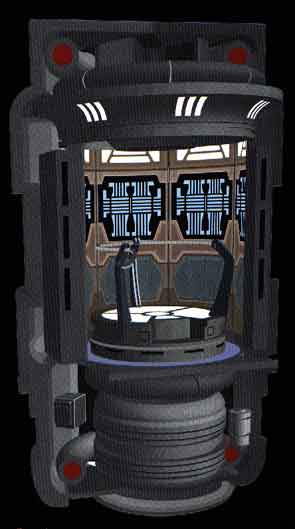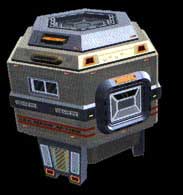COMMAND SYSTEMS
The Defiant Class is equipped with a battle-ready bridge and shipwide systems control. The bridge contains the typical complement of control stations, with the addition of a redundant tactical station designed to handle increased weapons system crew workloads. An integral master situation monitor and conference table allow the crew to study and plan strategies and tactics during reduced action periods. Engineering and science stations have been included and have dedicated ODN lines to the main computer and critical systems, though neither is absolutely vital to the opeartion of the ship in battle. A single forward flight control (conn) and operations (ops) station replaces the traditional helm and navigation stations.
COMPUTER SYSTEMS
Twin isolinear processing cores are situated just aft of the bridge on Decks 2 and 3. The total computer core possesses 675 banks of chromopolymer processing and storage sheets, for a total capacity of 246.87 megaquads. The system is normally powered by an EPS shunt from the aft impulse reactors, but can be powered by a smaller regulated EPS conduit from the warp core. Cooling of the isolinear systems is accomplished by a regenerative liquid nitrogen loop, which incorporates a delayed-venting heat storage block for stealth activities. The typical mission requirements for the main computer involve only 45% of the processing and storage capacity. The other 55% is reserved for intelligence-gathering or tactical operations, or taking over for a damaged core. Defiant Class can operate on a single core and can even retain some critical data from a damaged area through compression and scattered storage methods.
SCIENCE AND REMOTE SENSING SYSTEMS
The Defiant Class is equipped to perform highly detailed scientific missions, especially those concerned with defensive operations. While not outfitted for extended scanning and analysis tasks, the suite of onboard systems is well suited for 82% of the standard astrophysical, biological, and planetological sweeps and accompanying data reduction. A loadout of 10 mixed class-1, -3, and -5 probes is normally provided at a nearby starbase layovers and can be supplemented with class-8 and -9 quantum torpedo-derived probes. The external long- and short-range sensors are adapted from standard sensor pallets and set behind selectively EM-opaque hull plating. In most battle situations, the sensor clusters can retreat into reinforced wells until action levels have been reduced and then brought into closer contact with the hull plates. All sensor inputs are recorded and analyzed within the computer core and displayed at the science panels on the bridge, or on padds, tricorders, or other displays around the ship. Most sensor systems have been optimized for reconnaissance and spacecraft combat maneuvers.
UTILITIES AND AUXILIARY SYSTEMS
All standard EPS, fluid transfer, ODN lines, atmospheric, and other energetic and consumable systems are installed aboard Defiant Class. The EPS conduits and ODN fiber bundles have been reinforced with jackets of multilayer woven polyduranium. Onboard gravity is provided by 153 improved stator-rotor gravity generators. Solid waste disposal is handled by compaction-desiccation units. Replicators are furnished for crew foodstuff and inorganic-object production, and are connected to raw matter and recycling tankage. Cryogenic fuels are moved by standard magnetic-peristaltic conduits. Limited-capacity turbolifts provide access to key locations on the ship, primarily along its length. A small number of Jefferies tubes provide access to systems between and behind major compartments and deck structures.
COMMUNICATIONS SYSTEMS
All standard RF and subspace communications systems are installed, with additional capacity for narrow-beam and encrypted signal transmission and reception. Stealth com is possible through modulated impulse exhaust streams and navigational deflector beams. A set of 3 primary and 3 backup subspace distress beacons is provided for emergency use.
TRANSPORTER SYSTEMS
A Defiant Class vessel normally carries one primary and one backup transporter on Deck 1. The modular unit includes a 45% scaled version of the standard pattern buffer tank and molecular imaging scanners found on larger starships. The transporter is powered by an impulse system EPS tap and is EM-shielded with a multilayer duranium jacket. The hull transporter emitter pads are armored with electroporous plating, which requires the computer to maintain tighter control over the ACB in terms of look angle in dwell time on both beam-up and beam-down targets.
ENVIROMENTAL SYSTEMS
Defiant is equipped with a standard suite of Starfleet life support devices and supplies. A normal class-M environment is maintained, but can be adapted in three of the crew living quarters for life-forms from class-H, -K, or -L worlds. All atmospheric conditions, heating, and humidity are controllable by deck and by section. All storable gases and fluids, as well as transfer and manipulation hardware, are distributed among all four decks and engineering spaces.
CREW SUPPORT SYSTEMS
The primary crew-support systems include the 22 main cabins, 10 contingency crew cabins, replicators and wardroom, and sickbay compartments. The crew cabins are equipped with a minimum of 2 bunks, and can be outfitted for as many as 6, for a potential total crew of 192. The normal operational crew is 40. The sickbay facilities are small, with space for 4 beds, expandable to 6, plus a limited surgical suite. The replicators are tied into the raw matter and recycling supplies and contain updated menus for various cultures. A pair of units is installed in the wardroom. |

|
AUXILIARY SPACECRAFT SYSTEMS
A Defiant class vessel can carry up to 4 small shuttlepods, each measuring 4.5 by 3.1 by 1.8 meters. Each can carry 2 operator crew and up to 4 additional passengers, or cargo. The shuttlepod is limited to impulse travel only, though it may travel for a short time at superluminal velocites if released at warp. The role of the shuttlepod is varied, including starship escape, planetary surface ops, and ship-to-ship transfers. The craft is equipped with limited phaser armaments, but can be modified to mount a number of small weapons systems.
Defiant class also carries Type-10 class shuttlecraft. It is a four-crew, multirole shuttle based on the Type-6 shuttlecraft spaceframe and equipped with subscale versions of larger starship impulse and warp propulsion systems. The craft measures 9.64 meters in length by 5.82 meters abeam by 3.35 meters in height. The basic unloaded mass is 19.73 metric tonnes, slightly heavier thn similar shuttles due to is larger warp coil assemblies. The warp nacelles are modeled after teh armored Defiant engine pods. Off-the-shelf RCS thrusters have been taken from the Type-6 spares inventory. Defensive systems mirror those of most other auxiliary spacecraft and encompass phaser emitters, micro-torpedo launchers, shields, and signal intelligence jamming devices.
Onboard computer systems include a shortened version of the Danube-class runabout computer core, partitioned into five polled processor segments for optimum decision-making. Provisions have been made for bioneural gel pack peripherals and upgrades. Planetary landing systems include both fixed and deployable surface pads. All other required hardware, such as formation lights, emergency beacons, transporter, pressure suits, and surface survival packs, are present in this model. The shuttlecraft bay has been built into Decks 3 and 4, immediately below the Defiant bridge. It includes an aft maintenance bay and split launch doors, and can be isolated or protected with force-fields. Variable gravity control in both sections is possible for launch, recovery, and certain systems repair work. An enclosed observation gallery may be used to oversee maintenance and flight operations. A large central tractor beam emitter has been installed for both normal and emergency berthing functions, and is augmented by a series of sixteen smaller docking beam emitters designed for low velocity vehicle translations.
EMERGENCY OPERATION SYSTEMS
| Aside from the escape options provided by the shuttlepods, the principal survival craft is the Starfleet lifeboat or escape pod. The current lifeboat is sized to include two main types, a 6-person and an 8-person version. The Defiant class carries 26 of the 6-person types, which measure 3.6 meters tall and 3.5 meters across the hexagonal faces. Each lifeboat contains enough consumables and recycling capabilities to keep the crew alive for eight months, longer with multiple lifeboats connected in standard "gaggle mode." All are equipped with navigational processors and impulse microthrusters, plus emergency subspace communication systems. The Defiant Class units have been specially modified for low-observability and minimal EM signatures due to the general wartime conditions. |

|

![]()